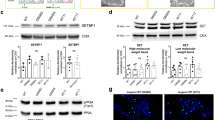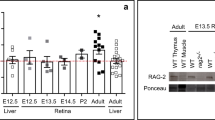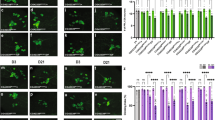Abstract
Harlequin (Hq) mutant mice have progressive degeneration of terminally differentiated cerebellar and retinal neurons. We have identified the Hq mutation as a proviral insertion in the apoptosis-inducing factor (Aif) gene, causing about an 80% reduction in AIF expression. Mutant cerebellar granule cells are susceptible to exogenous and endogenous peroxide-mediated apoptosis, but can be rescued by AIF expression. Overexpression of AIF in wild-type granule cells further decreases peroxide-mediated cell death, suggesting that AIF serves as a free radical scavenger. In agreement, dying neurons in aged Hq mutant mice show oxidative stress. In addition, neurons damaged by oxidative stress in both the cerebellum and retina of Hq mutant mice re-enter the cell cycle before undergoing apoptosis. Our results provide a genetic model of oxidative stress-mediated neurodegeneration and demonstrate a direct connection between cell cycle re-entry and oxidative stress in the ageing central nervous system.
This is a preview of subscription content, access via your institution
Access options
Subscribe to this journal
Receive 51 print issues and online access
$199.00 per year
only $3.90 per issue
Buy this article
- Purchase on Springer Link
- Instant access to full article PDF
Prices may be subject to local taxes which are calculated during checkout






Similar content being viewed by others
References
Cassarino, D. S. & Bennett, J. P. Jr An evaluation of the role of mitochondria in neurodegenerative diseases: mitochondrial mutations and oxidative pathology, protective nuclear responses, and cell death in neurodegeneration. Brain Res. Brain Res. Rev. 29, 1–25 (1999)
Sayre, L. M., Smith, M. A. & Perry, G. Chemistry and biochemistry of oxidative stress in neurodegenerative disease. Curr. Med. Chem. 8, 721–738 (2001)
Busser, J., Geldmacher, D. S. & Herrup, K. Ectopic cell cycle proteins predict the sites of neuronal cell death in Alzheimer's disease brain. J. Neurosci. 18, 2801–2807 (1998)
McShea, A., Wahl, A. F. & Smith, M. A. Re-entry into the cell cycle: a mechanism for neurodegeneration in Alzheimer disease. Med. Hypotheses 52, 525–527 (1999)
Yang, Y., Geldmacher, D. S. & Herrup, K. DNA replication precedes neuronal cell death in Alzheimer's disease. J. Neurosci. 21, 2661–2668 (2001)
Nagy, Z., Esiri, M. M. & Smith, A. D. Expression of cell division markers in the hippocampus in Alzheimer's disease and other neurodegenerative conditions. Acta Neuropathol. (Berl.) 93, 294–300 (1997)
Osuga, H. et al. Cyclin-dependent kinases as a therapeutic target for stroke. Proc. Natl Acad. Sci. USA 97, 10254–10259 (2000)
Katchanov, J. et al. Mild cerebral ischemia induces loss of cyclin-dependent kinase inhibitors and activation of cell cycle machinery before delayed neuronal cell death. J. Neurosci. 21, 5045–5053 (2001)
Herrup, K. & Busser, J. C. The induction of multiple cell cycle events precedes target-related neuronal death. Development 121, 2385–2395 (1995)
Migheli, A. et al. A cell cycle alteration precedes apoptosis of granule cell precursors in the weaver mouse cerebellum. Am. J. Pathol. 155, 365–373 (1999)
Gill, J. S. & Windebank, A. J. Cisplatin-induced apoptosis in rat dorsal root ganglion neurons is associated with attempted entry into the cell cycle. J. Clin. Invest. 101, 2842–2850 (1998)
ElShamy, W. M., Fridvall, L. K. & Ernfors, P. Growth arrest failure, G1 restriction point override, and S phase death of sensory precursor cells in the absence of neurotrophin-3. Neuron 21, 1003–1015 (1998)
Feddersen, R. M., Ehlenfeldt, R., Yunis, W. S., Clark, H. B. & Orr, H. T. Disrupted cerebellar cortical development and progressive degeneration of Purkinje cells in SV40 T antigen transgenic mice. Neuron 9, 955–966 (1992)
Hammang, J. P. et al. Oncogene expression in retinal horizontal cells of transgenic mice results in a cascade of neurodegeneration. Neuron 10, 1197–1209 (1993)
Barber, B. R. Research news. Mouse News Lett. 45, 34–35 (1971)
Bronson, R. T., Lane, P. W., Harris, B. S. & Davisson, M. T. Harlequin (Hq) produces progressive cerebellar atrophy. Mouse Genome 87, 110 (1990)
Williams, J. Chemistry and Biochemistry of Flavoenzymes (ed. Muller, F.)) 121–211 (CRC Press, Boca Raton, 1995)
Susin, S. A. et al. Molecular characterization of mitochondrial apoptosis-inducing factor. Nature 397, 441–446 (1999)
Mustacich, D. & Powis, G. Thioredoxin reductase. Biochem. J. 346, 1–8 (2000)
Miramar, M. D. et al. NADH oxidase activity of mitochondrial apoptosis-inducing factor. J. Biol. Chem. 276, 16391–16398 (2001)
Joza, N. et al. Essential role of the mitochondrial apoptosis-inducing factor in programmed cell death. Nature 410, 549–554 (2001)
Heintz, N. & Zoghbi, H. Y. Insights from mouse models into the molecular basis of neurodegeneration. Annu. Rev. Physiol. 62, 779–802 (2000)
Hawes, N. L. et al. Retinal degeneration 6 (rd6): a new mouse model for human retinitis punctata albescens. Invest. Ophthalmol. Vis. Sci. 41, 3149–3157 (2000)
Coffin, J. M., Stoye, J. P. & Frankel, W. N. Genetics of endogenous murine leukemia viruses. Ann. NY Acad. Sci. 567, 39–49 (1989)
Taylor, B. A. & Rowe, L. A mouse linkage testing stock possessing multiple copies of the endogenous ecotropic murine leukemia virus genome. Genomics 5, 221–232 (1989)
Coffin, J. RNA Tumor Viruses: Molecular Biology of Tumor Viruses (eds Weiss, R.Teich, N.Varmus, H. & Coffin, J.) 261–369 (Cold Spring Harbor Laboratory, Cold Spring Harbor, New York, 1984)
Droge, W. Free radicals in the physiological control of cell function. Physiol. Rev. 82, 47–95 (2002)
Deisseroth, A. & Dounce, A. L. Catalase: physical and chemical properties, mechanism of catalysis, and physiological role. Physiol. Rev. 50, 319–375 (1970)
Baillie, T. & Slatter, J. Glutathione: a vehicle for the transport of chemically reactive metabolites in vivo. Acc. Chem. Res. 24, 264–270 (1991)
Mate, M. J. et al. The crystal structure of the mouse apoptosis-inducing factor AIF. Nature Struct. Biol. 9, 442–446 (2002)
White, A. R. et al. Survival of cultured neurons from amyloid precursor protein knock-out mice against Alzheimer's amyloid-beta toxicity and oxidative stress. J. Neurosci. 18, 6207–6217 (1998)
Costa, G. L. et al. Targeting rare populations of murine antigen-specific T lymphocytes by retroviral transduction for potential application in gene therapy for autoimmune disease. J. Immunol. 164, 3581–3590 (2000)
Shackelford, R. E., Kaufmann, W. K. & Paules, R. S. Oxidative stress and cell cycle checkpoint function. Free Radical Biol. Med. 28, 1387–1404 (2000)
Kurki, P., Vanderlaan, M., Dolbeare, F., Gray, J. & Tan, E. M. Expression of proliferating cell nuclear antigen (PCNA)/cyclin during the cell cycle. Exp. Cell Res. 166, 209–219 (1986)
Kimura, H., Ohtomo, T., Yamaguchi, M., Ishii, A. & Sugimoto, K. Mouse MCM proteins: complex formation and transportation to the nucleus. Genes Cells 1, 977–993 (1996)
Frade, J. M. Unscheduled re-entry into the cell cycle induced by NGF precedes cell death in nascent retinal neurones. J. Cell Sci. 113, 1139–1148 (2000)
Raina, A. K., Zhu, X., Monteiro, M., Takeda, A. & Smith, M. A. Abortive oncogeny and cell cycle-mediated events in Alzheimer disease. Prog. Cell Cycle Res. 4, 235–242 (2000)
Daugas, E. et al. Apoptosis-inducing factor (AIF): a ubiquitous mitochondrial oxidoreductase involved in apoptosis. FEBS Lett. 476, 118–123 (2000)
Mundy, W. R. & Freudenrich, T. M. Sensitivity of immature neurons in culture to metal-induced changes in reactive oxygen species and intracellular free calcium. Neurotoxicology 21, 1135–1144 (2000)
Griendling, K. K., Sorescu, D., Lassegue, B. & Ushio-Fukai, M. Modulation of protein kinase activity and gene expression by reactive oxygen species and their role in vascular physiology and pathophysiology. Arterioscler. Thromb. Vasc. Biol. 20, 2175–2183 (2000)
Lavoie, J. N., Rivard, N., L'Allemain, G. & Pouyssegur, J. A temporal and biochemical link between growth factor-activated MAP kinases, cyclin D1 induction and cell cycle entry. Prog. Cell Cycle Res. 2, 49–58 (1996)
Lee, E. Y. et al. Dual roles of the retinoblastoma protein in cell cycle regulation and neuron differentiation. Genes Dev. 8, 2008–2021 (1994)
Ackerman, S. L. et al. The mouse rostral cerebellar malformation gene encodes an UNC-5-like protein. Nature 386, 838–842 (1997)
Lynn, R. B., Bechtold, L. S. & Miselis, R. R. Ultrastructure of bombesin-like immunoreactive nerve terminals in the nucleus of the solitary tract and the dorsal motor nucleus. J. Auton. Nerv. Syst. 62, 174–182 (1997)
Sheldon, M. et al. Scrambler and yotari disrupt the disabled gene and produce a reeler- like phenotype in mice. Nature 389, 730–733 (1997)
Cambray-Deakin, M. A. Neural Cell Culture: A Practical Approach (ed. Wilkin, J. C. a. G.) 3–13 (IRL Press, Oxford, 1995)
Grignani, F. et al. High-efficiency gene transfer and selection of human hematopoietic progenitor cells with a hybrid EBV/retroviral vector expressing the green fluorescence protein. Cancer Res. 58, 14–19 (1998)
Acknowledgements
We thank C. Mathews for providing antioxidant antibodies; R. Smith and L. Dionne for technical assistance; J. Stockwell for statistical assistance; L. Bechtold and P. Finger for electron microscopy work; G. Martin and J. Smith for assistance with the images; and T. Gridley, E. Leiter, B. Knowles and P. Nishina for comments on the manuscript. This work was supported by NIH grants to S.L.A., a NIH training grant to J.A.K. and an institutional NCI cancer core grant.
Author information
Authors and Affiliations
Corresponding author
Ethics declarations
Competing interests
The authors declare that they have no competing financial interests.
Rights and permissions
About this article
Cite this article
Klein, J., Longo-Guess, C., Rossmann, M. et al. The harlequin mouse mutation downregulates apoptosis-inducing factor. Nature 419, 367–374 (2002). https://doi.org/10.1038/nature01034
Received:
Accepted:
Issue Date:
DOI: https://doi.org/10.1038/nature01034
This article is cited by
-
Impaired AIF-CHCHD4 interaction and mitochondrial calcium overload contribute to auditory neuropathy spectrum disorder in patient-iPSC-derived neurons with AIFM1 variant
Cell Death & Disease (2023)
-
The key players of parthanatos: opportunities for targeting multiple levels in the therapy of parthanatos-based pathogenesis
Cellular and Molecular Life Sciences (2022)
-
AIF Overexpression Aggravates Oxidative Stress in Neonatal Male Mice After Hypoxia–Ischemia Injury
Molecular Neurobiology (2022)
-
Effects of apple extract on the mechanism of apoptosis during acetic acid-induced colitis in Wistar rats
Nutrire (2021)
-
AIF3 splicing switch triggers neurodegeneration
Molecular Neurodegeneration (2021)
Comments
By submitting a comment you agree to abide by our Terms and Community Guidelines. If you find something abusive or that does not comply with our terms or guidelines please flag it as inappropriate.



